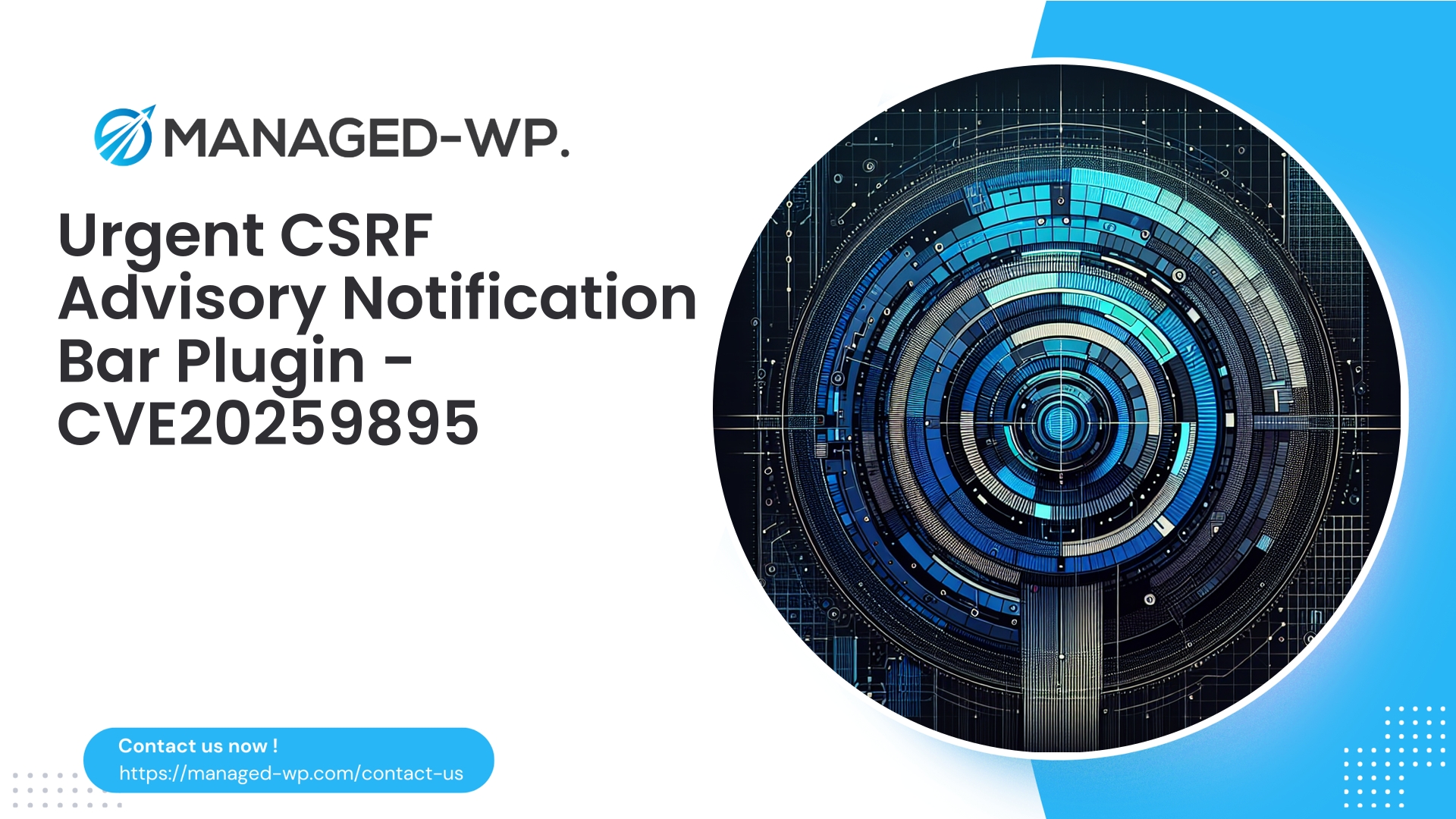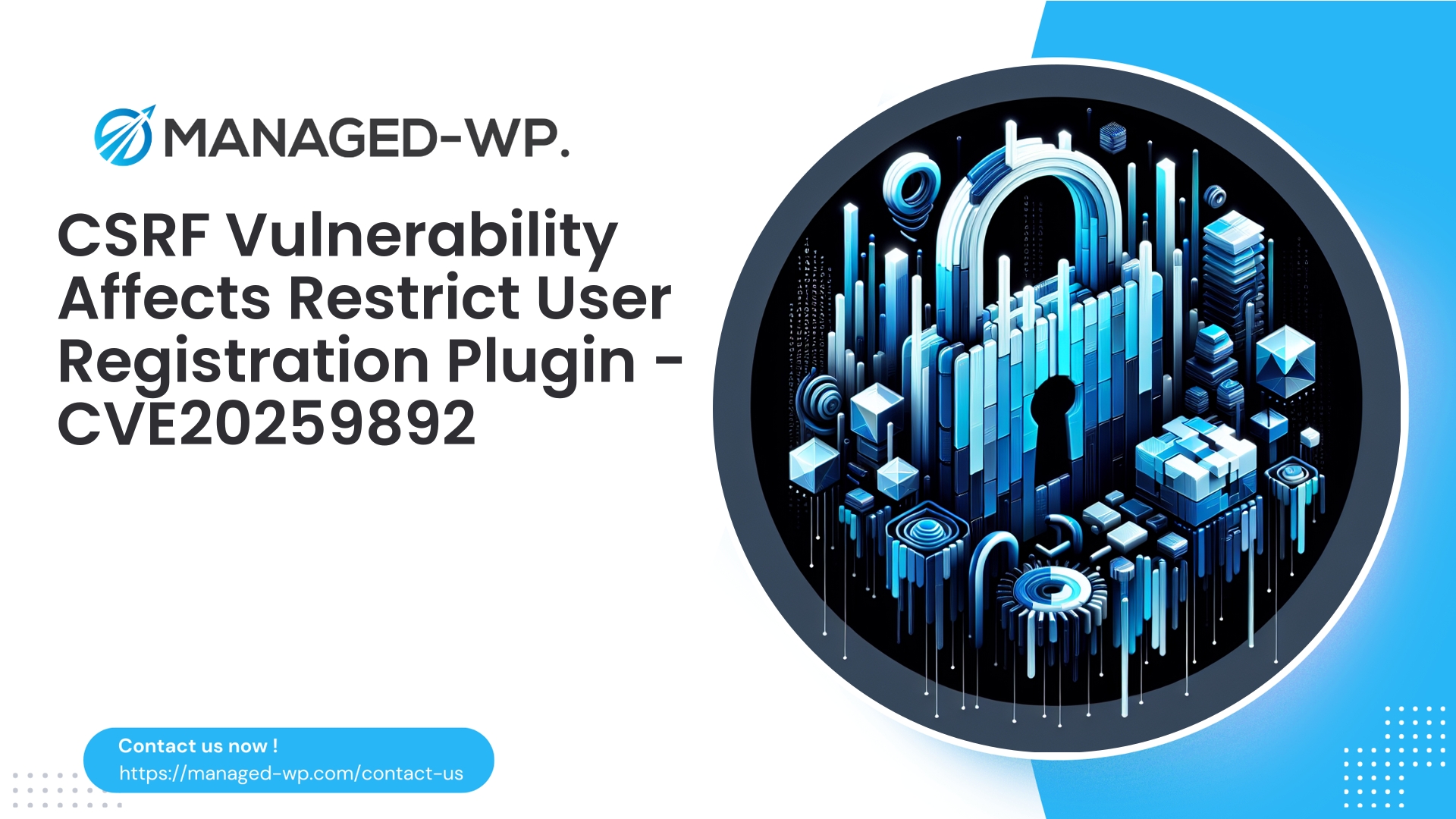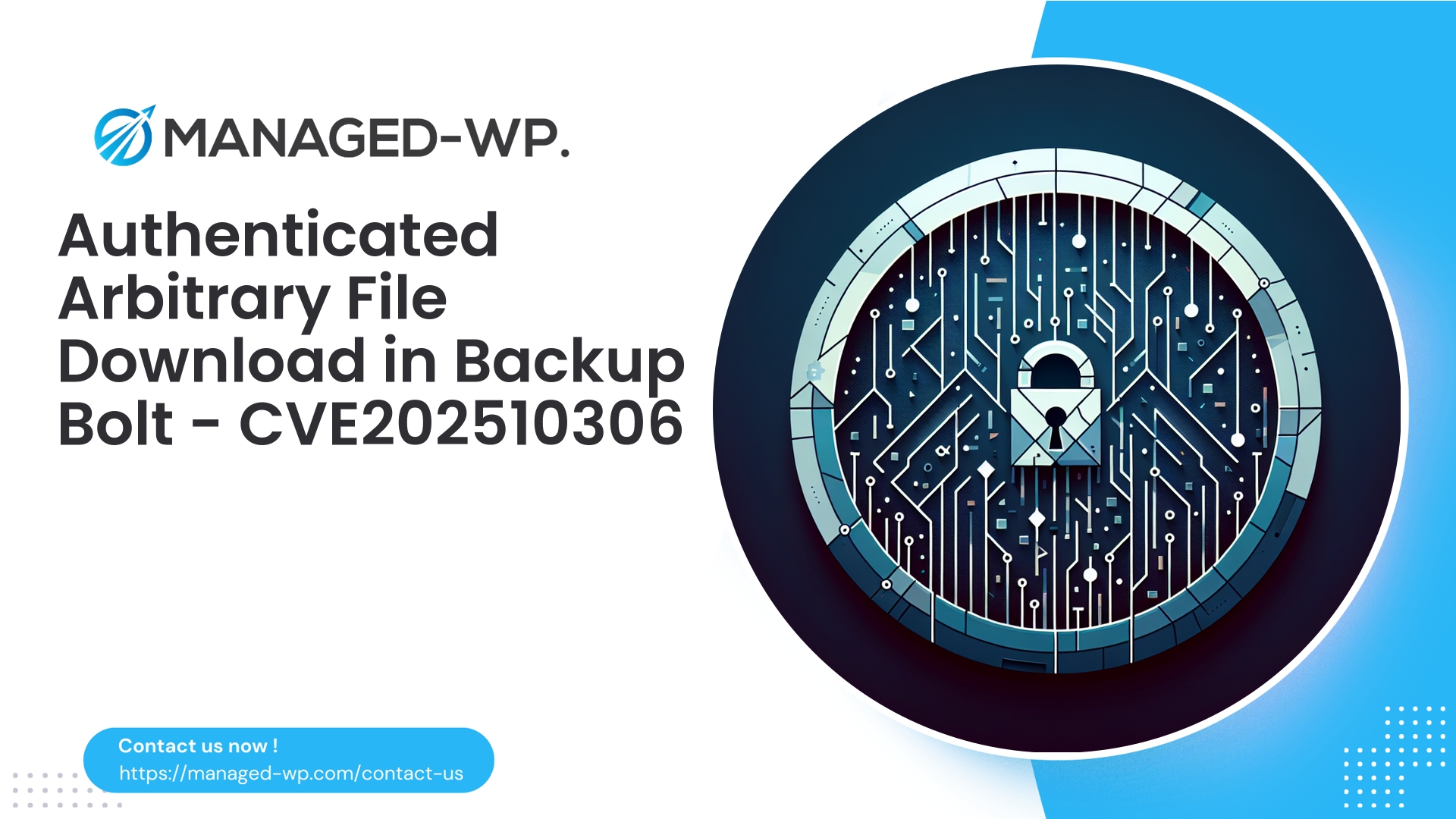| 插件名称 | 通知栏 |
|---|---|
| 漏洞类型 | CSRF(跨站请求伪造) |
| CVE编号 | CVE-2025-9895 |
| 紧急 | 低的 |
| CVE 发布日期 | 2025-10-03 |
| 源网址 | CVE-2025-9895 |
安全公告:通知栏(≤ 2.2)— CSRF 漏洞(CVE-2025-9895)
概括
- 受影响的软件: 通知栏(WordPress插件)
- 易受攻击的版本: 2.2 及以下版本
- 漏洞类型: 跨站请求伪造 (CSRF)
- 标识符: CVE-2025-9895
- 披露日期: 2025年10月3日
- CVSS评分: 4.3(低)
- 报道人: 独立安全研究员(公开披露)
- 官方补丁状态: 截至披露日期,尚未发布官方修复方案。
作为 Managed-WP 的安全专家,我们提供此安全指南,旨在清晰阐述此漏洞的性质、潜在影响、可立即采取的补救措施、推荐的 Web 应用防火墙 (WAF) 策略以及长期预防措施。我们的使命是为 WordPress 管理员和开发人员提供切实可行的安全优先措施,同时严格避免分享漏洞利用技术。
为什么这个漏洞很重要
跨站请求伪造 (CSRF) 漏洞会诱使攻击者欺骗已登录用户(尤其是管理员等拥有较高权限的用户)无意中提交未经授权的请求,从而构成安全风险。在通知栏插件的上下文中,这可能允许攻击者篡改显示的消息、修改配置或激活插件功能,从而提升权限或持续进行恶意活动。
虽然根据 CVSS 分类,此漏洞的严重性被归类为“低”,但网络安全的现实情况要求我们采取主动防御措施。低严重性漏洞往往会成为复杂攻击链中的跳板,尤其是在与弱密码、不充分的访问控制或其他漏洞结合使用时。及时采取缓解措施可以降低安全风险,并避免清理工作带来的高昂代价。
技术说明(防御概述)
该漏洞源于 Notification Bar 插件 2.2 及更早版本未能正确验证修改状态的请求。具体而言,由于缺乏强大的反 CSRF 令牌(nonce)或充分的功能检查,关键操作暴露在外。此缺陷允许攻击者构造恶意页面,当已认证的管理员访问这些页面时,即可通过受害者的会话触发未经授权的状态更改。
需要考虑的关键技术要点:
- WordPress 依赖于 nonce(通过
wp_nonce_field()和wp_verify_nonce()结合能力验证(当前用户可以()) 防御 CSRF 攻击。 - 某些插件功能错误地通过 GET 请求公开了状态更改操作,或者接受没有 nonce 验证的 POST 请求。
- 攻击者经常利用社会工程手段(例如网络钓鱼邮件或欺骗性广告)诱使有特权的用户访问利用 CSRF 漏洞的恶意网站。
我们只强调防御措施;不会分享攻击代码。
潜在攻击场景
这些假设场景说明了攻击者可能的目标,其目的仅在于提高认识和确定保护措施的优先顺序。
- 篡改通知消息,插入恶意重定向或钓鱼链接。
- 配置插件以公开显示敏感的调试信息或启用不安全的功能。
- 劫持第三方集成以注入攻击者控制的 JavaScript 代码。
- 利用 CSRF 漏洞以及薄弱的管理员凭证或缺少多因素身份验证,加深网站入侵程度。
即使是像切换横幅可见性这样看似微不足道的操作,也可能为进一步的攻击或持久性后门打开方便之门。
为网站所有者提供的即时建议(24-48小时内)
- 确认插件是否存在及其版本
- 登录 WordPress 控制面板,导航至“插件”→“已安装插件”,并验证 Notification Bar 是否已安装,以及其版本是否为 2.2 或更低版本。
- 如果您无法访问管理区域或怀疑发生安全漏洞,请立即启动事件响应流程。
- 降低风险暴露
- 首选: 一旦官方插件库或供应商提供补丁版本,请将插件更新到该版本。
- 如果目前还没有可用的补丁:
- 通过插件界面暂时禁用该插件。
- 如果移除插件不切实际,请使用 WAF 规则或虚拟补丁阻止其管理端点(详情如下)。
- 如果以上方法均无效,请通过重命名插件文件夹来禁用该插件。
wp-content/plugins通过 SFTP 或主机控制面板。
- 加强管理员访问控制
- 确保所有管理员账户都使用复杂密码。
- 在所有特权账户上启用多因素身份验证(MFA)。
- 尽可能通过 IP 地址限制管理访问权限,并考虑限制并发管理会话数。
- 未经授权变更审计
- 检查插件设置、通知内容和管理日志,查看是否存在异常情况。
- 检查是否有新创建或更改的管理员帐户。
- 留意帖子或页面上发布的可疑内容。
- 轮换凭证
- 更改所有管理员帐户的密码,以及插件可访问的 API 密钥或第三方凭据的密码。
- 通知相关利益攸关方
- 将潜在漏洞告知您的内部团队、托管服务提供商和客户(如适用)。
检测指标
- 检查 WordPress 活动和审计日志,查看是否存在在异常时间触发的意外设置修改或插件停用。
- 分析服务器访问日志,查找来自可疑来源或用户代理的向通知栏端点发送的 POST 请求。
- 执行文件完整性检查,将已安装的插件文件与存储库中的可信版本进行比较。
- 检查前端内容是否存在插入的 iframe、未知脚本或可疑 URL。
- 检查数据库条目,查找插件特定表或选项中的意外值或已修改值。
如果检测到可疑活动,请保护日志、拍摄网站快照,并在进行更改之前遵循恢复协议。
遏制和恢复程序
- 隔离
- 评估期间,将受影响的网站离线或启用维护模式。
- 尽可能将数据库和后端 API 隔离,以控制事件蔓延。
- 清理或修复
- 如有可用且经验证无误的事件前备份,请从中恢复。
- 如果没有备份:
- 通过重命名插件文件夹来禁用该存在漏洞的插件。
- 删除未经授权的用户。
- 重置所有特权账户的密码。
- 运行全面的恶意软件和后门扫描;清除发现的威胁。
- 通过与官方插件文件和 WordPress 核心文件进行比较来验证文件的真实性。
- 重新启用插件前请进行强化
- 等待官方补丁或考虑用更安全的插件替换该插件。
- 如果必须在更新之前使用该插件,请实施 WAF 和其他虚拟补丁来阻止攻击途径。
- 事件后审查
- 调查初始漏洞入口点并找出系统性缺陷。
- 找出根本原因,例如缺少多因素身份验证 (MFA)、软件过时或管理员权限过高。
WAF 和虚拟补丁建议
在官方补丁发布之前,我们强烈建议部署 WAF 规则以缩小攻击面。以下是一些规则概要——请根据您的 Web 应用防火墙的功能进行调整。
- 阻止对插件管理端点的未授权访问
- 示例:阻止对以下对象的请求
/wp-admin/admin-post.php或者/wp-admin/admin-ajax.php在哪里行动参数与通知栏操作匹配(例如,simple_bar_save,简单栏更新除非来自受信任的管理员 IP 或已验证的会话。
- 示例:阻止对以下对象的请求
- 拦截可疑的 POST 请求
- 阻止带有通知栏参数的 POST 请求(例如,
简单栏内容,简单状态栏,sb_options缺少有效的 WordPress nonce 或正确的 referer 标头。
- 阻止带有通知栏参数的 POST 请求(例如,
- 验证管理员操作的来源网址和用户代理
- 拒绝来自您域之外的请求或格式错误/为空的 user-agent 标头。
- 限制请求频率或阻止重复请求
- 对反复向插件管理资源发送 POST 请求的可疑 IP 地址进行限流或屏蔽。
- 通过响应修改实现虚拟补丁
- 拦截并向插件管理表单注入服务器端 nonce 验证(适用于托管环境)。
- 注意:这种先进的方法需要深厚的系统集成和专业知识。
- 监控和警报
- 启用对符合这些规则的 WAF 模块的警报,以便快速进行事件分类。
重要的: 务必先在监控模式下运行新的 WAF 规则,以确保正常的管理操作不会中断。
开发人员最佳实践
插件和主题作者应采取以下安全措施,以防止 CSRF 及相关漏洞:
- 对所有状态更改请求强制执行随机数
- 使用
wp_nonce_field()用于表单生成和验证 nonce检查管理员引用者()或者wp_verify_nonce()正在处理中。 - 避免单独信任 cookie 或请求数据。
- 使用
- 实施能力检查
- 称呼
当前用户可以()确保只有授权用户才能执行敏感操作。 - 不要仅仅依赖用户名或身份验证 cookie 的存在。
- 称呼
- 安全的 AJAX 端点
- 在处理管理员 AJAX 请求之前,请验证 nonce 值和用户权限。
- 状态变更时,优先使用 POST 请求而非 GET 请求。
- 确保不通过 GET 请求暴露状态修改操作。
- 对输入/输出进行清理和转义
- 使用数据清理函数对所有输入数据进行清理。
- 转义输出以防止跨站脚本攻击 (XSS) 和其他注入攻击。
- 纳入安全测试
- 开发单元测试和集成测试,以验证 nonce 和功能检查。
- 提供清晰的漏洞报告和修补策略。
为网站所有者提供运营安全增强功能
- 在生产环境部署之前,请定期在测试环境中更新所有插件、主题和 WordPress 核心。
- 限制管理员用户帐户,强制执行最小权限原则。
- 强制所有特权用户帐户启用多因素身份验证 (MFA)。
- 部署能够对新出现的插件漏洞进行虚拟修补的托管式 WAF 解决方案。
- 定期进行经过测试的备份,并异地存储。
- 启用并查看管理操作的综合活动日志。
- 严格遵守密钥管理原则——一旦密钥和凭证泄露,应立即轮换使用。
- 限制或禁用不必要的 XML-RPC;使用范围限定且安全的应用程序密码。
- 在可行的情况下,采用 IP 地址白名单机制来管理管理员访问权限。
安全测试程序
- 直接从 WordPress 后台查看通知栏插件版本——避免外部探测。
- 检查服务器日志,查找针对插件端点的异常 POST 请求,但不要尝试主动利用漏洞。
- 利用测试环境或隔离环境安全地运行漏洞扫描器或渗透测试。
- 使用静态代码分析工具检测插件代码中缺失的 nonce 实现。
事件响应快速指南
- 一旦怀疑网站遭到入侵:隔离网站,保存所有相关日志,并立即停用存在漏洞的插件。
- 重置管理员凭据并轮换相关密钥。
- 仔细扫描文件和数据库,查找入侵迹象。
- 尽可能从可信备份中恢复。
- 加强访问控制,包括多因素身份验证和IP限制。
- 重新激活插件前,请进行彻底的审核。
机构和托管服务提供商沟通指南
对于管理客户网站的代理机构:
- 及时通知受影响的客户,并提供明确的补救措施。
- 提供应用 WAF 缓解措施或安全禁用易受攻击插件方面的帮助。
- 如果必须继续使用,则应实施严格的管理限制并强制使用多因素身份验证。
- 记录已采取的行动,并在事件解决后提供事件摘要。
虚拟补丁的作用
在WAF层部署的虚拟补丁,在漏洞披露和官方修复之间的这段时间里,起到了至关重要的临时保护作用。这些补丁可以实时阻止恶意请求,从而降低直接风险。
- 阻止针对插件设置的定向 POST 请求。
- 过滤掉缺少正确引用来源或 nonce 验证的请求。
- 尽可能将插件端点访问权限限制在受信任的 IP 地址范围内。
注意:虚拟补丁必须精心设计,以防止干扰合法的管理活动。
持续监控与持续改进
- 部署后 1-2 周内,监控 WAF 日志中被阻止的尝试,并调查潜在的误报。
- 保留详细的事件日志,以便为未来的安全态势提供信息。
- 定期扫描并重新评估插件的使用情况和配置。
- 优先进行补丁测试,并在官方修复程序发布后尽快推出。
常见问题 (FAQ)
问:我必须立即禁用通知栏插件吗?
答:如果厂商尚未发布补丁,禁用插件是最安全的短期防御措施。如果通知栏功能对业务至关重要,请采取 WAF 缓解措施并限制管理员访问权限,直到官方更新发布为止。
问:匿名攻击者能否利用此 CSRF 漏洞?
答:CSRF 攻击需要经过身份验证的受害者(通常是管理员)执行非预期操作。虽然匿名用户无法直接利用此漏洞,但风险仍然很高,因为攻击者可以诱骗管理员访问恶意页面来触发攻击。
问:我的主机提供商能否协助进行缓解措施?
答:当然。许多托管服务提供商都提供Web应用防火墙(WAF)规则部署、恶意软件扫描、备份和虚拟补丁服务。请联系您的服务提供商,尽快激活这些保护措施。
负责任的披露
发现类似漏洞的安全研究人员和开发人员应该:
- 将发现的问题通过插件作者指定的安全联系人或可信的漏洞赏金计划报告给插件作者。
- 如果答复被无故拖延,应负责任地协调公开披露事宜,以最大限度地延长政府的辩护时间。
立即获取托管式 WordPress 保护(免费计划)
首先使用 Managed-WP 的基本保护——免费计划
在安全方面,及时防护至关重要。Managed-WP 提供免费的基础套餐,提供关键的托管安全功能,可立即帮助您保护 WordPress 网站:
- 托管防火墙和 WordPress 优化的 WAF 规则
- 通过我们安全的保护层,流量不受限制。
- 针对OWASP十大威胁的全面恶意软件扫描和缓解
立即注册,即可在评估插件更新或执行清理操作时获得即时基础防御: https://my.wp-firewall.com/buy/wp-firewall-free-plan/
高级方案提供自动恶意软件清除、自定义允许列表/黑名单、详细的安全报告以及针对新发现的插件漏洞的自动虚拟修补。
Managed-WP 安全团队的最后寄语
我们始终致力于提供切实可行的风险规避建议,同时避免因泄露漏洞利用细节而损害安全性。WordPress 网站所有者应将此建议视为维护良好管理习惯的呼吁:尽量减少特权账户,强制启用多因素身份验证 (MFA),并在主机、网络和应用层实施多层防御。官方补丁发布后,请立即应用。
需要专家帮助?Managed-WP 可协助您进行虚拟补丁、监控和事件响应。我们的免费基础保护计划可在您制定全面补救计划的同时,提供即时安全保障。
保持警惕,注意安全,并确保您的 WordPress 环境保持最新状态。
— Managed-WP 安全团队



















